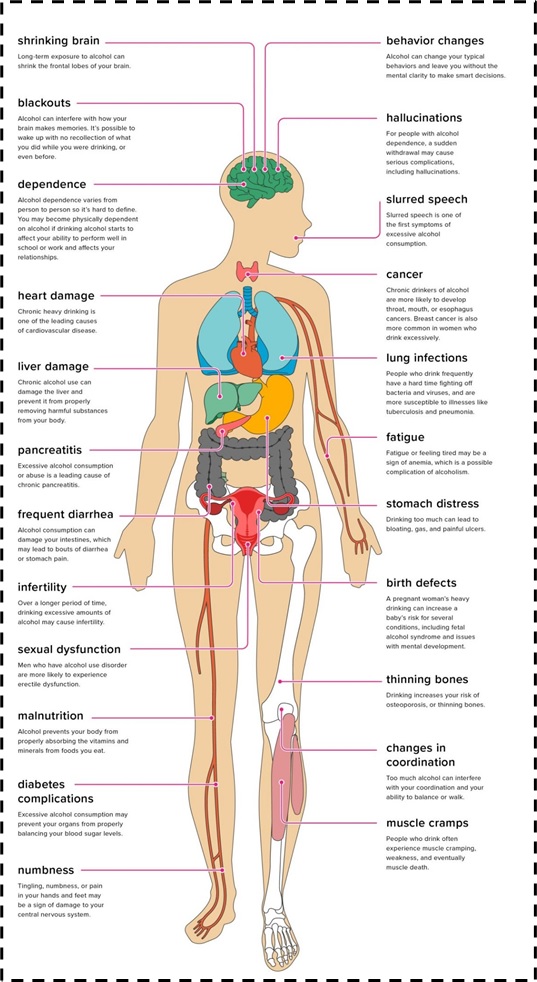● Worldwide, 3 million deaths result annually from harmful use of alcohol; this represents 5.3 % of all deaths.
● The harmful use of alcohol is a causal factor in more than 200 diseases and injury conditions.
● Alcohol consumption causes death and disability relatively early in life. In the age group 20–39 years, approximately 13.5 % of the total deaths are alcohol-attributable.
● There is a causal relationship between harmful use of alcohol and a range of mental and behavioural disorders, other noncommunicable conditions as well as injuries.
● The latest causal relationships have been established between harmful drinking and incidence of infectious diseases, such as tuberculosis, as well as HIV/AIDS.
● Beyond health consequences, the harmful use of alcohol brings significant social and economic losses to individuals and society at large.
Q. What happens when we drink alcohol?
When you drink alcohol, it first enters the digestive system. Unlike food or other drinks, approximately 20% of the alcohol from a single drink moves directly to the blood vessels and is carried to your brain. The other 80% goes to your small intestine where it is then absorbed into your bloodstream. The final step of the alcohol life cycle is its removal from the body through the liver. Any issues with your liver can slow this process, and prolong the effects of alcohol on your organs.
Once alcohol has entered your bloodstream, your body will begin to break it down, i.e. metabolize it, at a rate of 20 milligrams per deciliter (mg/dL) per hour. That means that if your blood alcohol level were 40 mg/dL, it would take about two hours to metabolize the alcohol.
Q. How long do the effects of alcohol last?
Though alcohol is metabolized at a constant rate, some people may feel the effects of alcohol for longer amounts of time. That’s because blood alcohol concentrations can vary among people and situations. Blood alcohol concentration (BAC) refers to the amount of alcohol in your blood in relation to the amount of water in your blood. For example, if two people each have blood alcohol levels of 20 mg/dL, the alcohol will metabolize in about an hour in each person, but their BACs can be very different.
Numerous factors can affect BAC and how you react to alcohol. These include:
- Age;
- Weight;
- Drinking alcohol on an empty stomach;
- Medications;
- Liver disease; and
- Drinking many drinks in a short period of time, ie. called ‘binge drinking.
It’s also important to know how much alcohol is in your drink as this will determine how long it takes to metabolize your drink. For example, spirits and wine tend to carry higher amounts of alcohol compared to beers.
Q. What is a safe amount of alcohol to drink?
Moderate alcohol use for healthy adults generally means up to one drink a day for women and up to two drinks a day for men.
Examples of one drink include:
● Beer: 12ounces (355 milliliters)
● Wine: 5ounces (148 milliliters)
● Distilled spirits (80%): 1.5ounces (44 milliliters)
Moderate alcohol consumption may provide some health benefits but isn’t completely risk-free, such as:
● Reducing your risk of developing and dying of heart diseas;.
● Possibly reducing your risk of ischemic stroke (when the arteries to your brain become narrowed or blocked, causing severely reduced blood flow);
● Possibly reducing your risk of diabetes; and
● An increased risk of some cancers, e.g. esophageal.
Eating a healthy diet and being physically active have much greater health benefits, and have been more extensively studied than the benefits of alcohol.
Q. What are the long term effects of regular alcohol consumption?
Heavy or high-risk drinking is defined as:
- More than three drinks on any givenday;
- More than seven drinks a week for women and for men older than age 65; or
- More than four drinks on any given day, or more than 14 drinks a week for men age 65 and younger.
Binge drinking is defined as four or more drinks within two hours for women, and five or more drinks within two hours for men.
Excessive drinking can increase your risk of serious health problems as illustrated in the diagram below:

Q. When should I not have alcohol?
In certain situations, the risks of alcohol consumption outweigh the possible health benefits. You should not have alcohol if:
- You’re pregnant or trying to become pregnant;
- You’ve been diagnosed with alcoholism or alcohol addiction, or you have a strong family history of alcoholism;
- You’ve had a hemorrhagic stroke (when a blood vessel in your brain leaks or ruptures);
- You have liver or pancreatic disease;
- You have heart failure or you’ve been told you have a weak heart; and
- You take prescription or over-the-counter medications that can interact with alcohol, e.g. certain antibiotics.
Q. When could I have a drink?
If you don’t drink alcohol, don’t start because of potential health benefits. However, if you drink a light to moderate amount and you’re healthy, you can probably continue as long as you drink responsibly.
DON’T DRINK AND DRIVE
